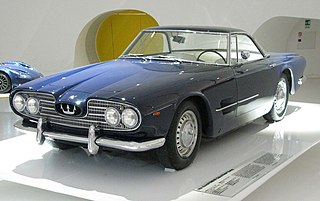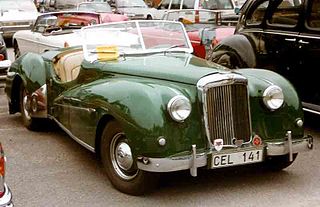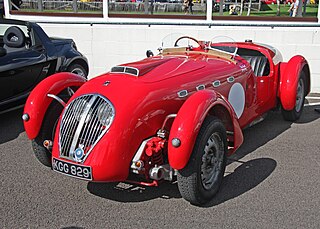
Nash Motors Company was an American automobile manufacturer based in Kenosha, Wisconsin from 1916 until 1937. From 1937 through 1954, Nash Motors was the automotive division of the Nash-Kelvinator Corporation. As sales of smaller firms declined after 1950 in the wake of the domestic Big Three automakers advantages in production, distribution, and revenue, Nash merged with Hudson Motors to form American Motors Corporation (AMC). Nash automobile production continued from 1954 through 1957 under AMC.
Donald Mitchell Healey CBE was a noted English car designer, rally driver and speed record holder.

Donald Healey Motor Company Limited was a British car manufacturer.

Jensen Motors Limited was a British manufacturer of sports cars and commercial vehicles in West Bromwich, England. Brothers Alan and Richard Jensen gave the new name, Jensen Motors Limited, to the commercial body and sports car body making business of W J Smith & Sons Limited in 1934. It ceased trading in 1976. Though trading resumed in 1998, Jensen Motors Limited was dissolved in 2011.

Alvis Car and Engineering Company Ltd was a British manufacturing company in Coventry from 1919 to 1967. In addition to automobiles designed for the civilian market, the company also produced racing cars, aircraft engines, armoured cars and other armoured fighting vehicles.

The Nash-Healey is a three-seat luxury sports car or grand tourer produced from 1951 to 1954. It was marketed by the Nash-Kelvinator conglomerate in North America as a halo car to promote sales of its Nash Motors division.

Duple Coachbuilders was a coach and bus bodybuilder in England from 1919 until 1989.

Tickford is an automobile engineering and testing business in Newport Pagnell, Buckinghamshire, known for tuning and such products as the 140 mph Tickford Turbo Capri.
SS Cars was a British manufacturer of sports saloon cars from 1934 until wartime 1940, and from March 1935 of a limited number of open 2-seater sports cars. From September 1935 their new models displayed a new name SS Jaguar.

The Daimler SP250 is a sports car built by the Daimler Company, a British manufacturer in Coventry, from 1959 to 1964. It was the last car to be launched by Daimler before its parent company, the Birmingham Small Arms Company (BSA), sold it to Jaguar Cars in 1960.

The Pegaso Z-102 is a Spanish sports car produced by Pegaso in Spain in both coupé and cabriolet form from 1951 until 1958. The Z-102 was the fastest production car in the world at the time of production, having reached a top speed of 151 mph (243 km/h).

The Maserati 5000 GT is a 2-door coupé car, made by Italian automobile manufacturer Maserati from 1959–1966. A total of thirty-four were produced with bodies made by eight different Italian coach builders.
Abbott of Farnham, E D Abbott Limited was a British coachbuilding business based in Farnham, Surrey, trading under that name from 1929. A major part of their output was under sub-contract to motor vehicle manufacturers. The business closed in 1972.

The Alvis TB 21 produced by Alvis cars was a two-seater open car based on the running gear of the TA 21 saloon and made only in 1951.

The Delahaye Type 175 is a luxury, bespoke, coachbuilt automobile manufactured by French automotive product manufacturer Delahaye. Production build numbers were formally recorded from early 1948 to mid 1951, validating that 107 cars were built.

The Austin London Taxicab used a modified Austin Heavy Twelve-Four chassis clothed with new bodies designed by London's largest taxicab retailer and dealer Mann & Overton, and made for them by London coachbuilders.

The Gentry is a British kit car styled to resemble a MG TF. It was offered for sale to the public by RMB Motors of Barwell, Leicestershire from 1974, the original prototype having been completed at the end of 1973. 15 kits were supplied in this first year, rising to over 80 per year produced in 1979.

The Simplex Automobile Company was formed in 1907 to take over the manufacturer of the S & M Simplex. The Simplex was an American luxury Brass Era automobile manufactured from 1907 to 1918. Headquartered with a manufacturing plant in New York City, manufacturing from 1912 was in New Brunswick, New Jersey. The Simplex Crane Model 5 was commonly called Simplex-Crane and Crane-Simplex. The Crane-Simplex Company of Long Island, New York was an attempt in 1922 to revive the brand but closed after only a few chassis were built.

The Healey Silverstone is an open, two-seat sports car produced by the Donald Healey Motor Company beginning in 1949. It is named for the Silverstone Circuit racetrack, where it appeared on its second competition outing. The car has a narrow roadster style body and cycle wings. Designed as a dual purpose car for both road and track, the Silverstone became popular in club racing.
John Charles & Co was a British coachbuilding company founded in 1932 and based initially near Kew Gardens, London.

















